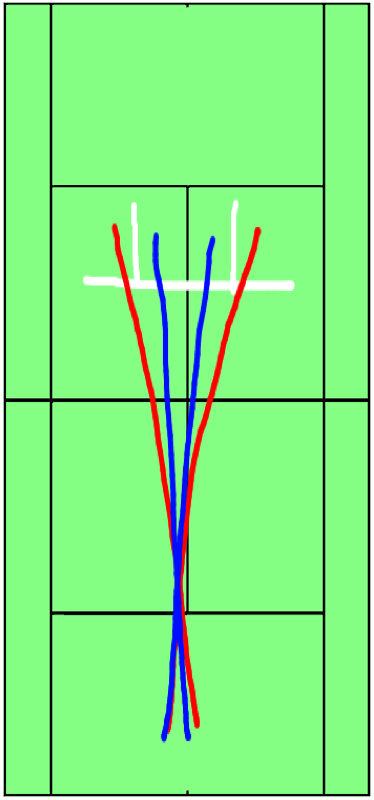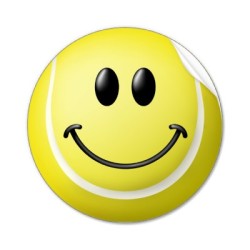Tennis has been compared to life, war, boxing, martial arts and a number of other human endeavors. Heck, I've even compared it to ballet through a minefield with a tennis racket in hand (yes, I have an active imagination). But the analogy that works best is probably war. Sure, nobody dies or gets injured but all the elements are there: weapons, strategy, tactics, elements, planning and preparation (both physical and mental). However, it's the planning aspect that really correlates the two activities. In order to devise a proper strategy (as well as tactics to implement the strategy) you must have a complete understanding of your opponent: stroke by stroke; attribute by attribute; characteristic by characteristic. Before doing battle, you must know your opponent better than he knows himself.
Often times, the only feedback is that the opponent is a righty and has a big forehand. That's a start. In the grand scheme of things, however, it's like saying that he's "half-white and good at square-dancing". It scratches the surface but doesn't quite get into the substance of the matter. Before preparing for a tough match - preferably the night before - try to approach the match as a general would approach a battle. Start by asking some questions about the opponent so that you have a better understanding of what's to come. Remember, this is only an exercise; you will not be right immediately or all the time. In many ways, breaking down your opponent is like appraising the value of a house: there are a number of factors to consider but in the end it's more art than science. However, by continuing to continuing to engage in this process you will become more proficient at it. At some point, you will face a 6'3" lefty from Perth, Australia (with a two-handed backhand) and you will identify him more by strategy than by name. Again, the underlying theory is that a BAD PLAN IS BETTER THAN NO PLAN AT ALL. A bad plan can be changed (particularly if you have back-up plans). If you have no plan, then it's harder to get one going on the fly (especially if you're down 2-3 breaks). So here are some questions to help you along the way. These are NOT the only questions and you have to formulate your own to assist you through this process.
1. Is the opponent a righty or a lefty? We've covered this before, but this a good starting point as it will assist you in visualizing his serves and weapons as well as your own serves and weapons.
2. Does he have a two-handed backhand or one? This can have various consequences based on your own attributes but it may assist you in figuring out whether to hit the ball high (usually against a one-hander) or low; make him pass you on the run (easier for one-handers than two-handers); where you serve (generally, one-handers hold a backhand grip on the returns); etc.
3. Is your opponent tall or short? Tall people like high balls and, generally, move better up and back than side to side. Short people usually like lower balls and are better moving side to side than up and back. If you hit a high ball, will it elicit a short response (around the service line) that you can thump?
4. Is he fast or slow? That is, how good does he cover medium distances around the court (e.g. baseline to net)? Slow people are like walls - they hate to move and love pace directed to them. If you make the opponent move will he (a) miss, (b) get tired and/or (c) hit short? If so, you can figure out a game-plan.
5. Is he quick? Unlike #4, above, this deals with how well the opponent adjusts to the ball and covers small distances. Someone can be fast but not quick. If they're not quick, wrong-footing them or hard body-shots sometimes work as they will not be able to change direction as well or adjust to your shots.
5. Is he strong or weak? That is, can he generate his own pace or does he feed off someone else's pace? Make a weak player generate his own pace. A strong player should be forced to generate pace from the most awkward positions (high/low/jam/slice).
6. What type of player is he? Serve and volleyer; baseliner; pusher; touch-player; all-around? What does he like to do; what does he not like to do? Who coaches him and do you know the coach? This may be a more advanced concept but there are certain "schools of tennis" throughout the world. Some produce big forehands; others have more of a serve and volley approach; some produced fighters; etc. If you know the "school" you will be in a better position to develop a counter-strategy. Furthermore, "indoor" players sometimes hit the ball flat and "without dimensions" (i.e. deep). Indoors is not as conducive to angles (maybe because the air is thinner) and, usually, favors bigger-flatter hitters (who, incidentally, are not accustomed to long rallies or sharp angles). If he's a high-altitude player, there's a chance that he might not hit the ball as hard when playing at sea level (since, at high altitudes, the ball tends to fly). However, high altitude players normally have incredible serves and strong lungs so it's important to be prepared for big serves and long points.
7. Who are the players that have beaten him? You want to defeat this opponent, correct?! Well, often times you're going to step outside of your own comfort zone and emulate another player. It doesn't have to be Roger or Rafa; it can be Johnny from down the street. What did he do to win.
8. What are his weapons and when does he like to use them? How does he use them? It's not enough to say that he has a big forehand. You have to know FROM where and TO where so that you can either stay away from it or know where to go if he manages to get a shot where he wants it. So, for example, in the first diagram below, which "X" represents his "kill shot(s)" and which question mark represents his preferred target(s)? In the second picture, from which height does he like to hit the ball: 2 feet off the ground (white line); 4 feet (purple); 5+ feet (red)? Not every player can hit the best shot from all positions so it's important to break it down three-dimensionally so that you can figure out exactly the spot to keep it away from.

9. Where does he like to serve under pressure? How good is his out wide serve? Kick-serve? Does he get nervous when you "crowd the T"? Does he have specific serving patterns (e.g., does he always starts the game with either flat "down the T" or a slice out wide)? If you chip and charge, does he start to get shaky on his passing shots?
10. How is is head? Is he a fighter? Is he smart? Does his concentration lapse? Is he better when he's in the lead than when he's behind? Can you "get in his dish" if you show some "game" (i.e. feistiness) or would it better if you were an iceberg? Is he patient or does he try to rush off the court?
11. Does she have obvious weaknesses and how does he defend them? Someone with a glaring backhand weakness will often plant herself in the backhand corner. Hitting MORE shots to the backhand won't get her out of that spot. You have to break some eggs and hit some shots to the forehand AND THEN pick on the backhand (like a dried booger).
12. If the opponent is an attacking player, is he just as good when he's BROUGHT in (e.g. through a drop shot or short, low-lying slice)? Some players will love to attack but only like to come in on their own terms. If you take the initiative and bring them in once in a while, they will be coming in unprepared. Sometimes, it's best to also try "taking the net away from them" by beating them to the net. For example, if you're first in, your opponent will be forced to play a defensive role - something she might not be accustomed of doing.
13. How is her overhead and backhand volley? These are two shots with which most young players struggle. It takes a great deal of pressure off you if you know that your opponent can't hit overheads to save his life or "duffs" the backhand volley short. If that's the case, when your opponent makes it to the net, belt the passing shot for the backhand and bolt in.
14. How does your opponent handle losing the first set? Does she usually "bag it" or is she a fighter. If so, maybe it's important to be fired up early and steal the first set away from her (obviously, "steal" DOESN'T mean cheat). Figure out the best way to "fire on all pistons" from the get-go. Don't rely on winning the second and third set. Scratch, fight and crawl for the first one.
15. How are the opponent's returns? Does she run around the backhand a lot? Maybe preparing for a slice serve to "keep her honest" would be a good play. Also, someone who routinely punishes the second serve return should not see many second serves to begin with (i.e., MAKE YOUR FIRST SERVE). Does he have specific targets that he likes to hit with the return? If so, cover them. Kids are NOT THAT SMART. They will, generally, do things over and over (even until they lose) without realizing that they're getting burned. All you have to do is figure out their patterns. Remember, if any of your opponents were actually good they'd BE ON T.V.
16. Does he have endurance (is he fit or fat)? Is he a fighter; could you "take him down" if you were 1-on-1 in a cage match with him? How many matches did he play the day before? Is he far away from home and homesick (i.e., looking for a "way to the airport")?
Etc.
As you progress through the sport, you will, hopefully, identify further issues and trouble spots. By being a "thinking player" you will often find yourself beating players who are far superior on paper. It all boils down to figuring out your opponents' likes/dislikes and tailoring around it. Will these strategies work for everyone? Of course, although many "pure hitters" will continue to do things without realizing whether they are doing the right thing or the wrong thing. Many will stumble onto the correct strategy over and over (until wily opponents figure out the best way to take them out of their game).
As a player, it is important to be confident but to FORGET ABOUT CONFIDENCE when you're faced with a tough match. Coldly analyze the facts and figure out how you would beat the opponent on your WORST day. Or, alternatively, figure out how to beat your opponent if you believe that, between the two of you, he is the best ball-striker. Don't assume that the chips will fall in your favor this time (or every time). Perhaps it helps to assume that things will NOT go your way. NOW HOW DO YOU WIN?! When you know that you can (and will) win on your worst day - THAT's true confidence (the rest is cockiness that masks uncertainty).
 Monday, October 31, 2011 at 12:48PM
Monday, October 31, 2011 at 12:48PM  CAtennis
CAtennis 


